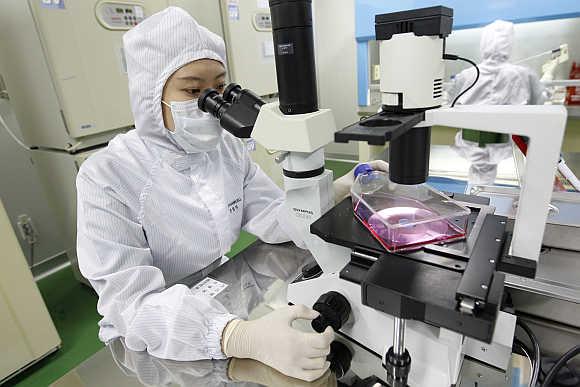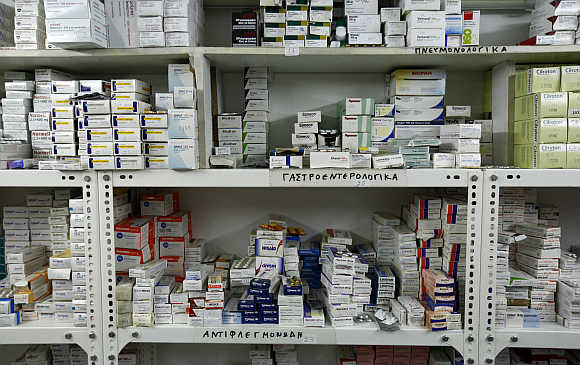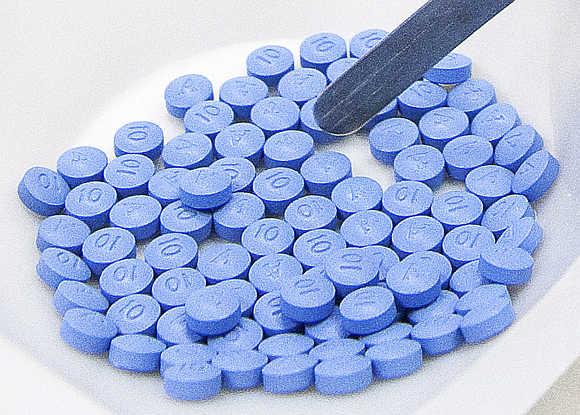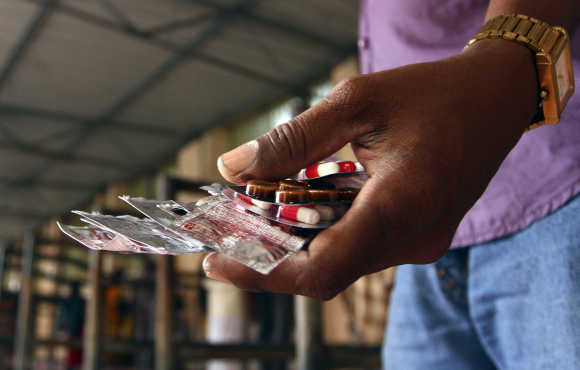Photographs: Jo Yong hak/Reuters Bhupesh Bhandari
Why have Indian authorities woken up to the Ranbaxy case only now? The matter had been simmering for several years, notes Bhupesh Bhandari
The Ranbaxy affair is one of the darkest chapters of India's business history.
The company has admitted it fudged data so that it could launch its products in the United States.
It has now paid $500 million as a penalty to settle the case.
It is worse than Ramalinga Raju cooking up the books of Satyam (bigger size=higher stature in the industry, higher profits=higher share price) because here medicine is involved -- something people consume, young and old, rich and poor, for their well-being.
In fact, India is yet to realise the full impact of this development.
. . .
Ranbaxy's dark chapter
Photographs: Ali Jarekji/Reuters
For several years now, patent-holding pharmaceutical companies have been running a campaign against those who produce inexpensive generic medicine in countries such as India and China; this gives their campaign a tremendous shot in the arm.
They need not say a word now.
The entire Indian generics industry is now under a ring of suspicion.
It will have to fight doubly hard in world markets.
There are three questions that need answers.
One, why have Indian authorities woken up to the issue only now?
The matter had been simmering for several years.
If Ranbaxy was cutting procedures and falsifying data for the heavily regulated US market, how do we know it wasn't doing so in India too?
. . .
Ranbaxy's dark chapter
Photographs: Ronen Zvulun/Reuters
It is an open secret that the sector is loosely regulated in India, though it must be said that it's not an easy task -- the number of drug companies in the country runs into several thousands.
It is only now, Business Standard has reported, that the health ministry has asked the Drug Controller General of India to examine all the dossiers and drug applications on the basis of which approvals had been granted to Ranbaxy in the past.
A news report that appeared in The Economic Times said that the DGCI had indeed probed the charges against Ranbaxy in late 2008 but decided against imposing a ban on its products.
There were three reasons for it: first, while the United States Food and Drug Administration, or FDA, had banned drugs made at Ranbaxy factories in Dewas in Madhya Pradesh and Paonta Sahib in Himachal Pradesh, drug regulators from developed countries such as Australia and the United Kingdom had inspected the factories and decided not to ban the drugs made there; second, the FDA did not recall the drugs already in circulation in the US; and third, the US continued to import a drug used in the treatment of HIV/AIDS made at Dewas and Paonta Sahib.
. . .
Ranbaxy's dark chapter
Photographs: John Kolesidis/Reuters
The DGCI had inspected the two factories and found nothing amiss. Now that Ranbaxy has admitted that good manufacturing practices were overlooked, the clean chit given by the DGCI doesn't make sense.
Two, why has Ranbaxy not moved against the people who are responsible for the violation of good manufacturing practices at Dewas and Paonta Sahib?
Why has it not taken to task those who were aware of it but stayed silent?
An operation of this scale cannot be carried out by some junior staff.
Nor is it just oversight.
A thorough investigation is required to find out who all were involved.
The truth needs to come out at all costs.
. . .
Ranbaxy's dark chapter
Photographs: Yorgos Karahalis/Reuters
Many of those people, it is possible, are working elsewhere; if this is what they have done in the past, their employers have every right to know.
Conversely, this is also an opportunity for many people to come out of it clean.
In fact, the then directors of the company also need to speak out on the matter.
Dinesh Thakur, the former Ranbaxy employee who turned whistle-blower, has said in the courts that he had carried out a detailed investigation on the matter and his superior, Rajinder Kumar, had apprised the senior management of it.
In September 2004, at a closed-door meeting in Thailand, Mr Kumar made a full presentation to the Ranbaxy board.
In December 2004, Mr Kumar made another presentation, this time to a subset of the board, the scientific committee.
. . .
Ranbaxy's dark chapter
Photographs: Handout/Reuters
If the allegations are true, a bigger lapse of governance will be hard to find.
In fact, Mr Thakur goes on to mention that Mr Kumar was asked to destroy the evidence of the fraud.
Three, did the Singh family sell a lemon to Daiichi Sankyo in 2008?
Was the Japanese company aware of the rot?
Did the Singh brothers make full disclosures?
The buyer doesn't think so.
"Daiichi Sankyo believes that certain former shareholders of Ranbaxy concealed and misrepresented critical information concerning the United States Department of Justice and FDA investigations.
. . .
Ranbaxy's dark chapter
Photographs: Babu Babu/Reuters
"Daiichi Sankyo is currently pursuing its available legal remedies and cannot comment further on the subject at this time," Daiichi Sankyo said in a statement posted on its website.
Malvinder Singh, the elder of the brothers, insists that the FDA charges were all in the public domain, Daiichi Sankyo's due diligence took place over months, and all allegations of impropriety are wrong.
In fact, he says that he just wanted a partnership with Daiichi Sankyo but the Japanese company wanted more and more of Ranbaxy as it carried out the due diligence.
That's how talks moved from selling a minority stake to a full sell-out.
Maybe the investment bankers involved in the deal could throw some light on this.









article